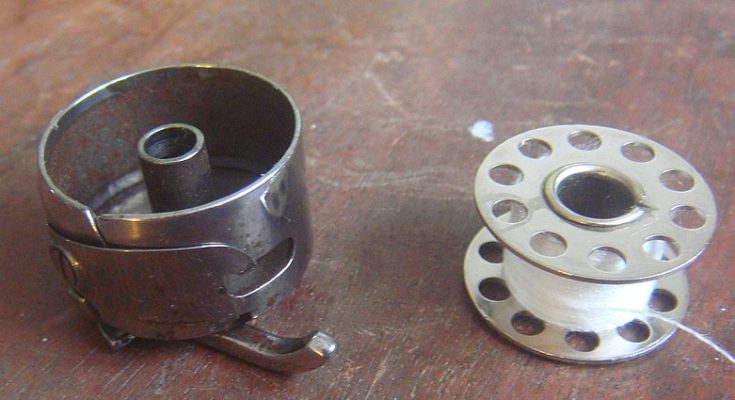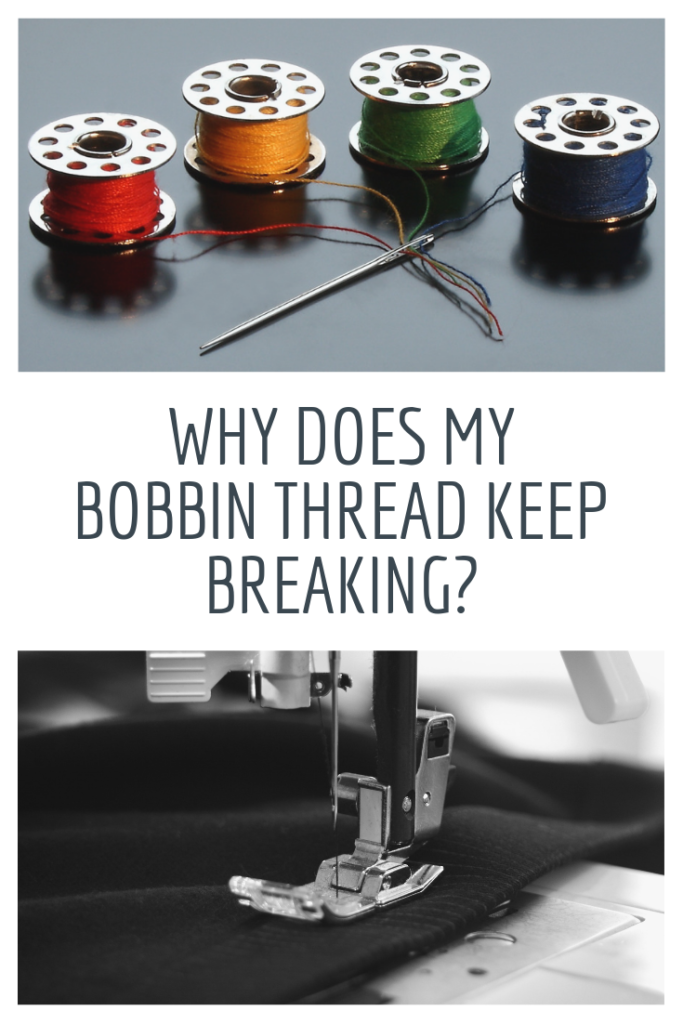Disclosure: This post may contain affiliate links. I earn a small commission when you click a link and make a purchase. Thanks for supporting SewingSociety.com!
If you’re having problems with your upper thread breaking, head over to this article: Why Does My Upper Thread Keep Breaking While I Sew?Here are ten reasons why your bobbin thread can break, and what to do about each one.
Contents
Your Sewing Machine Is Not Threaded Correctly
Even people who have been sewing for years sometimes thread their sewing machines incorrectly. This is the first thing you should check if your stitches do not look right or your bobbin thread keeps breaking.
Unthread your sewing machine and rethread it from the beginning. Make sure your thread take-up lever is in its highest position, attach your spool of thread, and then pull your thread through your tension discs and thread guides according to the instructions in your user manual. Then, pull your thread through the eye of your needle and leave a four-inch tail of thread.
Your Thread Is Poor Quality
Thread comes in several weights. Some thread is so fine it will snap from a little pull and some thread is so thick it will break in the eye of your needle or in your tension discs. If you’re using poor-quality thread, that might be the reason why it keeps breaking while you sew. Be careful when choosing thread for your sewing projects. Avoid buying thread in bulk packages because it tends to be poor quality. This thread is fine for hand sewing and small projects, but it might not be strong enough to handle machine sewing. If your bobbin thread keeps on breaking, try using better thread.
Your Thread Tension Is Too Tight
Your thread tension should be adjusted for different weights of fabric and thread. Make sure that you are using the same weight thread in both your bobbin and upper thread. If you don’t, the tension can be uneven and cause one of your threads to break.
Sewing machine manufacturers suggest that you don’t mess with your bobbin thread tension too much, but your thread should easily slide through your bobbin case. If it does not, you can make small adjustments to your bobbin tension by turning the screw on your bobbin case. If your bobbin tension is too tight, it can pull your thread and break it. Turn your tension dial counterclockwise to loosen it. If you can’t seem to get your tension right, a sewing machine repair technician can reset your bobbin tension.
Your Thread Is Snagging on a Burr in Your Bobbin Case
All the metal parts on your sewing machine are susceptible to burrs. These are sharp areas on the metal that are created as your thread rubs against them. Watch for burrs and sand them off when cleaning your sewing machine. Look for burrs on the underside of your throat plate, on your bobbin case, and on the spring in your bobbin case.
Your Bobbin Case Is Full of Lint
Lint builds up in your bobbin case as you sew. It can get in the way of your needle and prevent the hook in your bobbin case from forming stitches properly. Clean your sewing machine frequently to make sure your bobbin case and shuttle race are not jammed with lint.
Some bobbin cases also have an anti-backlash spring that can cause your bobbin thread to snag if you get too much lint underneath it. These springs are more common in industrial sewing machines. If your sewing machine has a spring in your bobbin case, take extra care to remove lint from underneath and around it.
Your Bobbin Is Inserted Backward
Not all sewing machines are the same. Some require you to insert your bobbin with the thread going clockwise and some require you to insert it counterclockwise. Most sewing machines have a diagram near your bobbin case to show you which direction to insert it. If not, check your sewing machine user manual. If you insert your bobbin backward, it will work for a few stitches and then your thread will snag and break.
Your Bobbin Is Not Wound Correctly
Most sewing machines have a bobbin winding mechanism. After several years of sewing, you’ll need to replace the washer on your bobbin winder for it to work properly. Look at your bobbin after you wind it to make sure your thread is wound evenly. If it does not look right, you may need to have your sewing machine serviced by a repair technician. You can also get a free-standing bobbin winder if your bobbin winder is broken.
Another thing to look out for is a knot in your bobbin thread. This can happen if you wind your bobbin by hand instead of using an automatic bobbin winder. Also, never wind your bobbin too full because it can prevent it from spinning freely in your bobbin case. Both these things can cause your bobbin thread to break.
You Are Using the Wrong Bobbin
All bobbins look similar. However, their dimensions are slightly different from model to model. Make sure that you only use bobbins that are compatible with your sewing machine. If they are too small, they can bounce around in your bobbin case and cause your thread to snag and break. If they are too big, they will not spin freely in your bobbin case.
Your Bobbin Is Warped or Damaged
Plastic bobbins can get warped by heat. If this happens, they will no longer fit in your sewing machine or work properly. Make sure you store plastic bobbins in a cool, dry place to prevent warping. If your bobbin thread keeps breaking, try winding a new bobbin and discard the old bobbin. This is often a simple fix to the problem.
Your Hook Timing Is Off
When your needle goes down, the hook system on your sewing machine creates a loop to form a stitch. If this does not happen, your hook timing is off. You can check by slowly lowering your needle through your needle plate and watching for the moment when it starts to go back up. This is when the loop should form.
You can try to fix the problem yourself or take your machine to a repair technician to have your hook timing reset. This is something that is checked whenever you take your sewing machine in for regular maintenance. Remember to always turn your handwheel toward you to avoid messing up the timing of your machine.
Did you find this article helpful?
I can help you solve other sewing machine problems, too! Get a copy of my book, Sewing Machine Problems and How to Solve Them on Amazon.
Your sewing machine is going to give you troubles again.
It’s inevitable…
My troubleshooting book walks you through how to solve the 20 most common sewing machine problems. You’ll be prepared to tackle any problem your sewing machine throws at you. That means more time sewing and less time crying.
The ebook version only costs $2.99. You’d easily pay between $75 and $150 to take your sewing machine to a repair technician. Learn how to do a lot of the sewing machine troubleshooting yourself and save money.
For more information, visit my Sewing Machine Troubleshooting Page.
Share this post on Pinterest!








While I am not “new” (55yrs), I am new to sewing. My mom taught me some sewing & I took Home Economics in Jr high (they don’t even teach that kind of class anymore) but that was 40+ years ago. I am now a pastor who ministers to an unsheltered homeless community & have found that in order to best provide for our community, I’m gonna need to take up sewing🤪! My mom passed this past year so I can’t learn from her now 😩& I needed help! Lol. It was great to stumble your website which is quite thorough, covers a vast amount of information and is detailed and easy to understand. Thank you & blessings to you!